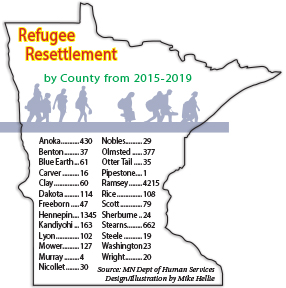Bob Oehrig, executive director of Arrive Ministries, spoke with the Pipestone Star about the process of resettling refugees in Minnesota in a Jan. 15, 2020 piece.
Here is an excerpt from the article:
Most of the time, Oehrig said, refugees are placed based on preference. About 95 percent of those who resettle in Minnesota do so to be near family members who are already in the state.
[pullquote style=”right” quote=”dark”]They want to work. They want to see something better for their family than they’ve experienced.”[/pullquote]If a refugee has no family to rejoin, the Department of State assigns them to one of the national agencies and the national agency refers them to one of its local affiliates throughout the country based on that local agency’s capacity. For 2020, Oehrig said Arrive Ministries was approved to place 104 refugees. The local agency then places the refugee based on a community’s capacity as far as available housing, schools, work and other factors.
Oehrig said Arrive Ministries and the other agencies (Catholic Charities of Southern Minnesota, Minnesota Council of Churches, Lutheran Social Services of Minnesota and the International Institute of Minnesota) provide case management services, and help the refugees find housing, connect with language services, navigate their new community, obtain Social Security cards, establish bank accounts and provide other support to help them start life in a new place. They also help them obtain clothing, furniture and other necessities.
Oehrig said the State Department provides the agencies with $1,000 for each refugee they place to help provide those services. The agencies also receive funds from corporate, private and faith-based donors.
Each refugee also receives a one-time allotment of $1,125 from the Department of State. Oehrig said the local agencies administer the funds, which are provided to help the refugees pay for rent, groceries and other necessities until they secure jobs.
Each year DHS’s Resettlement Programs Office receives approximately $5 million in federal funds to support the statewide resettlement of refugees and their integration into Minnesota Communities.
Oehrig said it’s important for refugees to obtain jobs once they are settled because after six months they have to start paying back the federal government for air fare and other travel expenses related to their transportation to the U.S.
“It’s not like they’re getting a free ride,” Oehrig said.
Typically, he said, the refugees he works with arrive ready and willing to work.
“They want to work,” he said. “They want to see something better for their family than they’ve experienced.”
Oehrig said historically most of the refugees who have settled in Minnesota are Karen, Bhutanese, Somali, Congolese and from the former Soviet Union. In southwest Minnesota, he said many Karen people have settled in Marshall and Worthington.
Oehrig said the reasons the refugees have fled their countries of origin vary, but that there is often tension or active war in the countries they come from and they are at risk of persecution or death due to their religious, social or political affiliations.
A Look at the Numbers
- Among Minnesota counties, Ramsey County has taken in the largest number of refugees over the last five years at 4,215 with Hennepin County second with 1,345.
- There have been 8,128 refugees who have resettled in Minnesota as a whole over the last five years, with decreasing numbers in recent years.
- The five-year high was 3,059 refugees in fiscal year 2016 and the low was 663 in 2018. There were 848 refugees who settled in Minnesota in 2019.
DHS attributes the decline in recent years to “the Trump administration’s annual lowering of the national admissions cap.” The cap for fiscal year 2020 is 18,000, which is the lowest in U.S. history, according to DHS. The ceiling was 30,000 in 2019 and 45,000 in 2018, according to the Migration Policy Institute.
Oehrig said the cap was over 200,000 in the 1980s and had typically been around 75,000 to 80,000 over the last 20 years prior to Trump taking office.
According to the UNHCR, there are 25.9 million refugees in the world.
“About .5 percent of the world’s refugees ever get resettled to another country,” Oehrig said.
This excerpt was taken from a Jan. 15, 2020 article in Pipestone Star Newspaper





